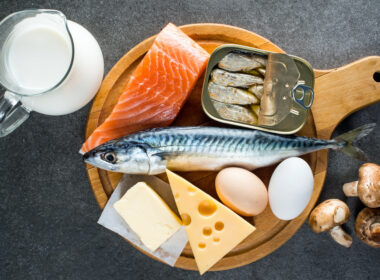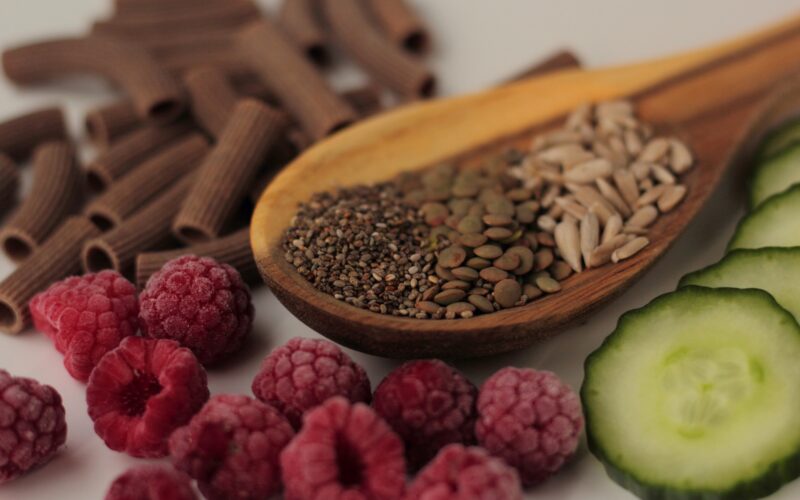“I’ve done so many diet programs, but I can’t lose weight.”
“My problem is my willpower. I just need to work harder.”
As a registered dietitian nutritionist trained in functional nutrition, these are just a few of the very common quotes I hear from my clients struggling with polycystic ovary syndrome (PCOS). Fortunately, there are multiple simple strategies to support healing and weight management with PCOS that do not require extreme restriction or superhuman willpower.
Understanding PCOS as a metabolic disorder
In the past and often still to this day, PCOS has been treated mainly as a reproductive hormone issue. Mayo Clinic and Cleveland Clinic, among other well-known medical organizations, currently frame PCOS this way. However, some compelling recent research suggests that PCOS is actually better understood as a metabolic condition that leads to imbalance(s) in reproductive hormones [1]. In fact, the main metabolic driver of PCOS may be insulin resistance [2].
This understanding of PCOS as a metabolic disorder is supported by the high prevalence of insulin resistance in women with PCOS, affecting up to 75% of lean PCOS sufferers, and up to 95% of overweight PCOS sufferers [3]. For many women with PCOS who struggle to lose excess weight, insulin resistance is likely one of the main culprits. Luckily, in my clients’ experience, insulin resistance can often be managed and even reversed with nutrition and lifestyle changes.
While sweets and other sugary foods and drinks definitely play a role in driving up insulin resistance, focusing only on avoiding these foods often leaves women still struggling with insulin resistance. Why is that? We have to understand the more complex nature of how your metabolism functions to regulate your blood sugar.
Insulin and blood sugar regulation
In normal metabolism, when blood sugar begins to rise in response to carbohydrate intake, insulin hormone is released to allow the sugar in the bloodstream to enter the cells of our body. Insulin works to keep blood sugar within an ideal range. Once insulin “unlocks” the cells of our body, sugar enters the cells and can be utilized for either energy production in the moment or stored as energy for later. This energy is stored either in the form of stored sugar called glycogen or converted into body fat.
When the input of sugar into the bloodstream over time is excessive, more and more insulin is required to do the same job of keeping blood sugar levels within a tight range. Over time, frequently or always being in this state of excess insulin, or hyperinsulinemia, can eventually lead to insulin resistance, which occurs when the insulin in your body is not properly received at the “doors” of your cells, thus requiring even more insulin to regulate your blood sugar. This vicious cycle of more and more insulin circulating in the body is problematic.
Insulin resistance leads to reproductive hormone imbalance and weight management challenges
The process of blood sugar regulation by insulin is a key factor in many of the hormonal issues and other negative symptoms often experienced by women with PCOS. High levels of insulin in response to rises in blood sugar can actually lead to hormone imbalance across the body—reproductive hormones, thyroid hormones, cortisol, etc. How can this be?
Effects on testosterone balance
In PCOS, high levels of circulating insulin due to insulin resistance both stimulate the ovaries to produce more testosterone, and inhibit the binding of testosterone to sex hormone binding globulin (SHBG) (when SHBG and testosterone are bound in circulation, testosterone’s availability is decreased) [4]. Together, these two effects lead to high levels of available testosterone and other androgen hormones like DHEA. High levels of androgens are often associated with common symptoms of PCOS such as acne, excess hair growth on the face and other areas of the body (hirsutism), and male pattern hair loss.
Effects on estrogen and progesterone balance
In addition to androgen hormone imbalance, insulin resistance can also lead to disturbances in levels of estrogen, progesterone, luteinizing hormone (LH), follicle stimulating hormone (FSH), and cortisol [5,6]. This cascade of hormonal disturbance caused by insulin resistance often leads to other common symptoms felt by women with PCOS, including fatigue, sleep disturbances, food cravings (often for sweets and starchy foods), and weight gain. Often, these symptoms can create a vicious cycle. Cravings for starchy or sweet foods lead to more blood sugar imbalances and higher insulin levels, which leads to even more cravings, fatigue, and weight gain.
Effects on sugar storage in the body
As previously stated, insulin drives storage of sugar as both glycogen and body fat, both of which can be used for future energy production. However, while insulin is in circulation, our body is in a “storage mode” rather than “fat burning mode” [7]. In insulin resistance, the higher levels of circulating insulin lead to excess body fat storage, and decreased opportunity for utilizing that stored body fat as a source of energy during times of caloric deficit (when our body is using up more calories than it’s taking in).
We can see that insulin resistance is a common denominator amongst many of the symptoms of PCOS. The good news is that insulin resistance can be managed through simple nutrition and lifestyle changes.
Managing insulin resistance with metabolic diet & lifestyle
Using good nutrition to manage insulin resistance does not have to be complicated. Here is my simple nutrition framework for insulin resistance that many of my clients with PCOS have used to see incredible improvements in hormone balance, weight, energy levels, and reduced cravings:
- Eat protein, fat, & fiber at every meal. We’ll call this PFF.
- Moderate your carbohydrate intake to healthier levels (hint: we can still have some carbs!)
- Eat real, whole foods that are nutrient dense, support nutrient repletion and reduce inflammation.
Let’s break those tips down a bit further.
Tip #1: Eat protein, fat, & fiber (PFF) at every meal
Protein, healthy fat, and fiber help to slow down the rise in blood sugar that happens when we eat foods made of carbohydrates. Protein, in particular, is the most satiating of all macronutrients. Many women I work with experience dramatic reduction in cravings and increased energy levels simply by increasing their intake of protein at their meals, since the protein alone greatly improves satiety and blood sugar balance.
I recommend always pairing carbs with a good serving of protein to prevent a spike in blood sugar. A good rule of thumb for including PFF at each meal is to aim for:
- At least 25g of protein at each meal and 5g or more for snacks.
- At least 1-2 servings (about 15-30g) of fat per meal
- At least 10g fiber per meal (fiber naturally occurs in all plant foods, but is often removed in highly processed foods)
Tip #2: Moderate your carbohydrate intake to healthier levels
The fear and confusion around carbs is consistently among the biggest challenges that my clients with PCOS experience. But the reality around carbs and metabolic health is two-fold: carbs can be part of a healthy diet and, at the same time, limiting carbohydrates usually reduces insulin resistance [8,9].
For many women, embracing this reality might look like keeping to one serving of higher carb foods at each meal. Of note, all plant foods contain carbohydrates, but some are higher in carbs while others, like non-starchy vegetables, avocados, nuts and seeds, are lower in carbs. Examples of one serving of higher-carb foods include 1 cup fruit, 3/4 cup cooked whole grains, and ½ cup beans or lentils.
Tip #3: Eat real, whole foods
The more we eat whole or minimally processed foods, the more nutrients we take into our bodies. Nutrients provided by whole- and minimally-processed foods include essential vitamins and minerals as well as beneficial antioxidants, essential omega 3 fats, and more.
Antioxidants are particularly helpful for reducing the oxidative stress that drives inflammation in the body. Inflammation on its own can make cells in the body more resistant to receiving insulin. Conversely, insulin resistance can promote weight gain, which contributes to increased inflammation.
More than a hormonal condition, PCOS is perhaps better understood as a metabolic condition, with insulin resistance serving as a key metabolic driver of hormone imbalance and other negative symptoms (including weight gain, for many women with PCOS). Understanding the role that insulin plays in metabolism and weight management empowers women to confidently make effective food choices. This helps women with PCOS clear the confusion about nutrition and overcome limiting beliefs that often hinder healing, such as an overemphasis on one’s own willpower to beat cravings.
Utilizing the nutrition framework emphasizing balanced meals and consumption of real, whole foods is one simple and effective strategy available to women seeking to improve their PCOS-associated insulin resistance.
References:
[1] Visser JA. “The importance of metabolic dysfunction in polycystic ovary syndrome.” Nat Rev Endocrinol, vol.17 (2021): pp. 77–8. https://doi.org/10.1038/s41574-020-00456-z [2] Torchen LC. “Cardiometabolic Risk in PCOS: More than a Reproductive Disorder.” Curr Diab Rep, vol. 17, no. 12 (2017). P. 137. doi: 10.1007/s11892-017-0956-2 [3] “International evidence-based guideline for the assessment and management of polycystic ovary syndrome.” Monash University, Melbourne, Australia. (2018) ISBN-13:978- 0-646-98332-5 [4] Baptiste CG, et al. “Insulin and hyperandrogenism in women with polycystic ovary syndrome.” J Steroid Biochem Mol Biol, vol. 122, nos.1-3 (2010): pp.42-52. doi: 10.1016/j.jsbmb.2009.12.010 [5] Rosenfield RL, Ehrmann DA. “The pathogenesis of polycystic ovary syndrome (PCOS): The hypothesis of PCOS as functional ovarian hyperandrogenism revisited.” Endocr Rev., vol. 37, no. 5 (2016): pp. 467-520. doi:10.1210/er.2015-1104 [6] Geer EB, Islam J, Buettner C. “Mechanisms of glucocorticoid-induced insulin resistance: focus on adipose tissue function and lipid metabolism.” Endocrinol Metab Clin North Am, vol. 43, no. 1 (2014): pp. 75-102. doi: 10.1016/j.ecl.2013.10.005 [7] Stenkula, Karin et al. “Insulin controls the spatial distribution of GLUT4 on the cell surface through regulation of its postfusion dispersal.” Cell Metabolism, vol. 12, no. 3 (2010): pp. 250-59. doi: 10.1016/j.cmet.2010.08.005 [8] Ebbeling, Cara et al. “Effects of a low-carbohydrate diet on insulin-resistant dyslipoproteinemia: a randomized controlled-feeding trial.” The American Journal of Clinical Nutrition, vol. 115, iss. 1 (2022): pp. 154-62. https://doi.org/10.1093/ajcn/nqab287 [9] Foley, Peter J. “Effect of low carbohydrate diets on insulin resistance and the metabolic syndrome.” Curr Opin Endocrinol Diabetes Obes, vol. 28, no. 5 (2021): pp. 463-8. PMCID: PMC8500369 PMID: 34468401 doi: 10.1097/MED.0000000000000659Additional Reading:
Insulin resistance, PCOS, and fertility health: are you at risk?
My journey to find real treatment for PCOS
The emotional effects of PCOS: the lies it tells me, and how I battle them
Natural options for managing PCOS
What are the symptoms of PCOS, and how do you treat it?
How Whole30 Helped Me Manage my PCOS and Overcome Infertility







